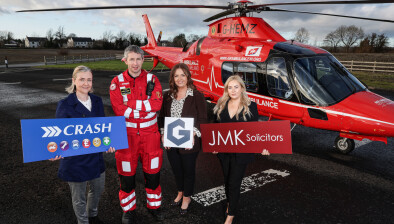High Court: Garda riding motorbike awarded €85,000 in general damages following collision with driver

The High Court has determined that a garda who collided with a driver who pulled out in front of him is entitled to €85,000 in general damages.

About this case:
- Citation:[2024] IEHC 19
- Judgment:
- Court:High Court
- Judge:Mr Justice Paul Coffey
Delivering judgment for the High Court, Mr Justice Paul Coffey had particular regard to the fact that the man’s “main injuries were to different arms” and that he was rendered “more helpless and dependent on others” than if the injuries involved only one upper limb.
Background
The plaintiff garda sued for personal injuries which he sustained in a road traffic accident on 18 September 2021. He was riding a Garda motorbike on the Drumcondra Road when the defendant drove out of a junction and across his path, causing him to collide with her car and to be propelled into the air and to land 12 feet away.
Having been transferred by ambulance from the scene to the Mater Misericordiae University Hospital, the plaintiff was discovered to have suffered a severely displaced and angulated fracture to the shaft of the radius and ulna of his non-dominant left forearm, with a severe intra-articular fracture dislocation of his dominant right wrist.
The plaintiff also suffered testicular bruising from the impact with his motorbike and other soft tissue injuries including bruising to his inner thighs, chest and ribs.
The plaintiff underwent major orthopaedic reconstructive surgery in which his bones were aligned and stabilized by open reduction and internal fixation using a metal plate, two rods and screws. He was discharged from hospital the next day but was unable to use his arms and was completely dependent on his wife for washing, dressing and eating. The plaintiff also suffered mental distress and nightmares.
The plaintiff returned to work on full duties after 12 months following diligent efforts to rehabilitate himself and attendance at physiotherapy sessions, but he complained that he was no longer as confident in handling Garda motorcycles due to fatigue in his left arm and difficulty using his right wrist. He also reported that he failed a test which would have qualified him for VIP escort work, which he believed he would have passed but for the accident.
In April 2023, the plaintiff’s orthopaedic surgeon commented at his clinical review that despite some persistent but mild restrictions on his ability to lift and carry, the plaintiff had made a “remarkable recovery” from what could have been a “life-changing” injury. The plaintiff’s surgeon estimated that he had a risk of developing arthritis in his right wrist of less than 25 per cent.
The defendant’s orthopaedic expert similarly found that the plaintiff was left with residual and permanent weakness in both limbs together with intermittent pain, stiffness and loss of motion, with a curtailment on his ability to lift more than 10kg.
The plaintiff also sustained a number of highly visible scars from his surgeries, and was left with an “unsightly” soft tissue mass on his left arm.
Liability was admitted by the defendant and special damages agreed, so the only issue for determination by the High Court was the quantum of general damages.
The High Court
Mr Justice Coffey began his analysis by confirming that the matter was to be decided by reference to the Personal Injuries Guidelines. The judge noted that where multiple injuries were involved, his task was to identify the most significant injury and the bracket of damages to which it belongs and to uplift that value to fairly and justly compensate the plaintiff for the additional pain, discomfort and limitations arising from lesser injuries.
Mr Justice Coffey considered that a trial judge must follow “a two-stage process”, firstly ensuring that the plaintiff is fully compensated for all their pain and suffering by reference to the Guidelines, and applying the principles of fairness and proportionality in order to assign a value to each injury that is fair to all parties and proportionate.
The court stated that the second step is “to ensure that the overall award is itself fair to all parties and proportionate. This requires the trial judge to step back from the individual injuries and their corresponding assigned values in order to holistically evaluate the cumulative effect of all of the injuries on the plaintiff and to adjust the ultimate award in order to avoid over or under compensation.”
Mr Justice Coffey observed: “In carrying out this task, the trial judge must have regard to the overlap of injuries and the maximum and equivalent awards available under the Guidelines for suffering of similar gravity to that of the plaintiff’s overall injury profile. Where a discount is applicable, the method of adjustment…appears to be of little practical consequence provided that the ultimate award of general damages is so measured as to achieve overall fairness and proportionality.”
The judge considered that fairness required him to take particular account of the life-threatening nature of the accident, the plaintiff’s surgery, his distress upon initially learning that his fractures could be life-changing, the permanent disfigurement of his arms, the extensive orthopaedic appliances still in place and the residual deficits with negative effects on his work.
The court also accounted for the considerations at 7.G of the Guidelines in respect of the plaintiff’s dominant right wrist, such as the plaintiff’s young age, the risk of degenerative changes and arthritis, his inability to work for a year and the effect of the injuries on his self-care. Mr Justice Coffey noted that to be fair to the defendant, the plaintiff had made a substantial recovery and that the risk of arthritis was not high enough to be a probability.
Finding the injury to the plaintiff’s left forearm to be the most serious and agreeing with counsel for the plaintiff in respect of the injury falling within second tier of the “severe” bracket, the court valued the injury at the lower end of €55,000 to reflect the plaintiff’s substantial recovery.
In respect of the plaintiff’s right wrist, the court found the injury to straddle the moderate and serious categories of wrist injury, valuing the injury at €42,000. By agreement of the parties, the court in its discretion valued the plaintiff’s soft tissue injuries at €3,000.
Turning to the discount to be applied, Mr Justice Coffey considered that the injuries occurred to both arms, rendering the plaintiff more helpless and dependent on others during his recovery than if one upper limb had been injured. Consequently, a discount of €15,000 was made.
Conclusion
Accordingly, the court measured general damages in the sum of €85,000.
Keogh v Byrne [2024] IEHC 19











